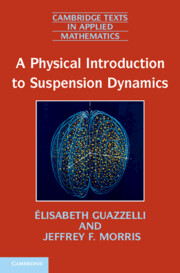8 - Beyond Stokes flow: Finite inertia
Published online by Cambridge University Press: 05 June 2012
Summary
In this chapter, our primary purpose is to go beyond Stokes flow to tackle the very difficult problem of understanding the influence of fluid inertia on particle-laden flows. Specifically, the issue of interest is the effect of inertia at the particle scale. Following the structure of the preceding two chapters, we consider first the influence of inertia on sedimentation, and then on shear flows of particle-laden fluid, where we will also consider the rheological consequences of inertia. Inclusion of inertia changes the form of the equation of motion, and even weak inertia can have singular effects when large domains are considered; for both sedimentation and shear, we provide a sketch of results obtained using the singular perturbation method of matched asymptotic expansions in the limit of weak inertia, i.e. at small Reynolds number. While Stokes flow is a good approximation near the particle, a pronounced change in symmetry of the disturbance flow caused by the particle is seen if we are far enough away, as the fore–aft symmetry of Stokes flow is completely lost in this “far-field” region.
We can only give an outline of the subject of inertial suspension flow, as most issues are far from completely resolved. In the previous two chapters, the issues which remain unclear are primarily collective, whereas the microhydrodynamic theory is well-established. For inertial suspensions, the level of understanding at the microscopic, i.e. single and pair, level is incomplete. Hence understanding of collective phenomena based on the microscopic physics is not well-developed and may expand rapidly.
- Type
- Chapter
- Information
- A Physical Introduction to Suspension Dynamics , pp. 192 - 212Publisher: Cambridge University PressPrint publication year: 2011

